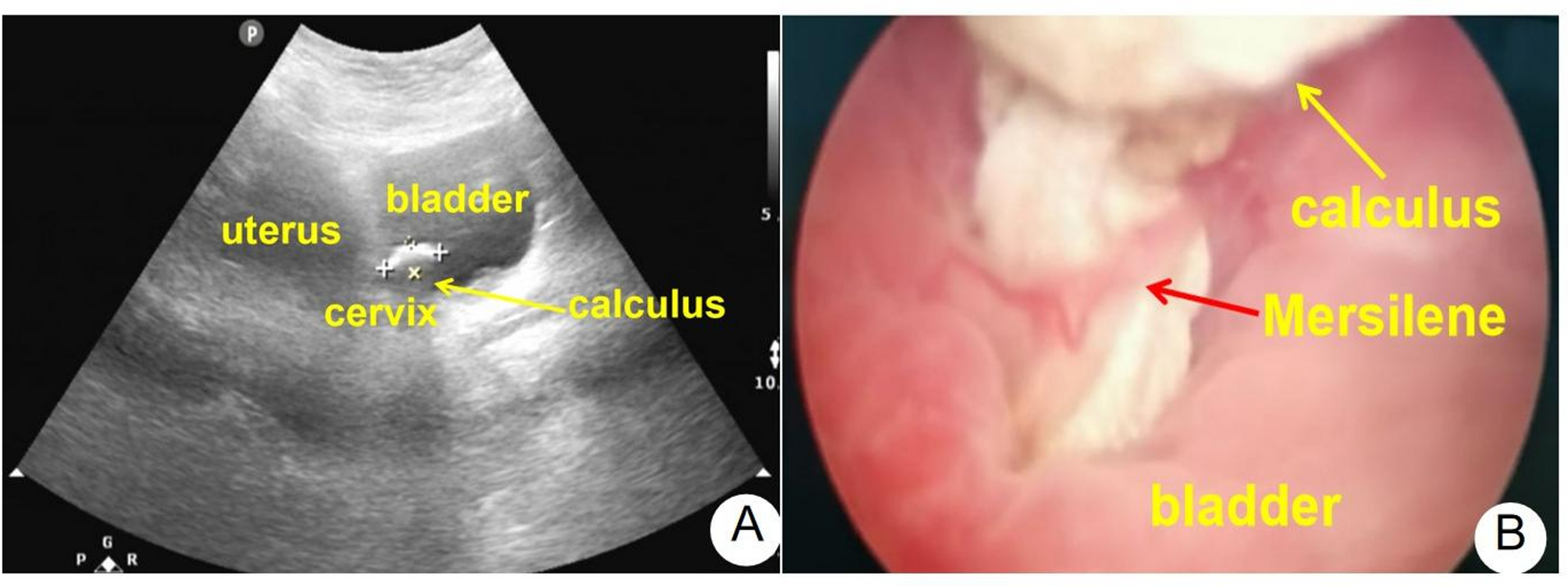In this case, the Mersilene tape caused penetration of the cervix resulting in erosion of the bladder and subsequent calculi formation, leading to symptoms of urinary tract infection. However, the site of penetration was not associated with bladder rupture or fistula formation. In previous case reports, there have been reports of the cerclage line eroding organs or forming genital fistulas after vaginal or abdominal cerclage. The vaginal cerclage methods include the McDonald method and the Shirodkar method. The latter requires a higher suture position and requires stripping the overlying bladder peritoneum to avoid the Mersilene tape adhering to the bladder. Based on the surgeon’s customary practices, the placement of the knot of the cerclage line in front or behind the cervix is determined. Theoretically, anterior positioning of the knot may result in bladder erosion, whether posterior positioning may lead to rectal erosion. To date, there have been no documented cases of rectal erosion caused by the cerclage line. The potential impact of positioning the knot of the cerclage line behind the uterus on the reduction of significant erosive complications necessitates further investigation. Laveaux et al. [6] reported a case of intermittent vaginal bleeding following Shirodkar cerclage, in which the cerclage line was cut inside the cervical canal and a bladder-cervix fistula was formed. The symptoms disappeared following surgical intervention and removal of the sutures. The cause of this rare complication may be related to the Mersilene tape buried in the cervix, gradually eroding the cervix, and then eroding the urinary tract epithelium. Similarly, Golomb et al. [7] reported a case of bladder-cervix fistula formation after Shirodkar cerclage, with the primary clinical manifestation being urinary incontinence. After removing the cerclage line, bladder drainage was performed to promote the healing process of the fistula, and the patient’s condition improved. Bladder-cervix fistula was previously mistakenly thought to be a complication unique to Shirodkar cerclage, and there have been reports of two cases of bladder-cervix fistula formation after McDonald cerclage [9]. In one of the cases, the cerclage line was removed as scheduled one year after the surgery, and the remaining cerclage fragments were removed urgently ten years later due to repeated symptoms such as difficulty urinating, hematuria, and frequent urination during which bladder calculi were found. Multiple sutures of lines were found at the bottom of the bladder. It is speculated that even after the second attempt to remove the cerclage line, the suture material was still retained in the tissue between the vagina and the bladder. There may also have been multiple suture lines placed during the initial cerclage, and over time, the retained suture lines migrated, ultimately eroding the bladder and causing the formation of calculi [8]. Togas et al. [4] also described a case of recurrent urinary tract infections and hematuria caused by complete penetration of the Mersilene tape through the bladder during laparoscopic surgery. Similarly, the suture in this case also eroded the bladder and led to the formation of calculi. The reason may be related to the lack of surgical experience of doctors in primary hospitals, which caused the Mersilene tape to be too close to the bladder at the first time or the incorrect separation of anatomical layers during operation. The Mersilene tape may also penetrate the cervical canal, emphasizing the importance of using hysteroscopy to check the integrity of the cervical canal at the end of routine surgery [5]. Therefore, it is also important to screen for relevant cerclage in patients with complaints related to the urinary system. In this case, the symptoms of the urinary system occurred two months after the operation and the corresponding treatment was not given until nearly one year after the operation, which is worth pondering. This alerts us that it is equally important to carry out related screening for cerclage patients with complaints of urinary tract discomfort.
In conclusion, for patients with cervical incompetence, the implementation of laparoscopic cervical cerclage prior to pregnancy can significantly enhance the success rate of the surgical procedure. However, it is crucial to monitor for potential long-term complications associated with the use of Mersilene tape, particularly the erosion of adjacent organs and the formation of bladder calculi.
